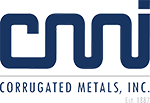One of the biggest myths about corrugated metal siding and roofing is that it is ugly and drab. Visions of poorly designed Quonset huts and mundane backyard sheds might even come to mind. In reality, corrugated metal is a versatile, innovative, and often stunningly beautiful building material that is at the vanguard of the modern architectural movement.
Invented by Henry Palmer in the 1820’s, corrugated metal is to this day a common building material all throughout the world. Its staying power comes from a combination of durability (they last 2 to 3 times longer than asphalt shingles), utility, manageable weight, corrosion-resistance, and cost. For years, it got the reputation as an inexpensive and bland alternative to other roofing and siding materials, like wood, tile, and stone. However, over the past decade, designers and architects have fallen in love with the versatility of corrugated metal.
The fact of the matter is that corrugated metal roofs and siding have now attained “coolness.” It has found its way into all environments. Whether it is found in the middle of the hippest new urban neighborhood, on a beach, or down a classic country road; corrugated metal stands out as unique and attractive. Some of the biggest names in modern architecture, including Frank Gehry, Renzo Piano, and Glenn Murcutt, all have and continue to rely heavily on corrugated metal siding and roofs to create some of the most iconic buildings the world has seen.
Another reason for the corrugated metal renaissance is its unique ability to be energy efficient. Being “Green” is a major part of modern architecture. Properly coated corrugated metal roofs are not only appealing to the eye, but can also cut heating and cooling costs dramatically.
One can only hope the myths surrounding corrugated metal will vanish as more architects, designers, and building owners discover its true beauty.

